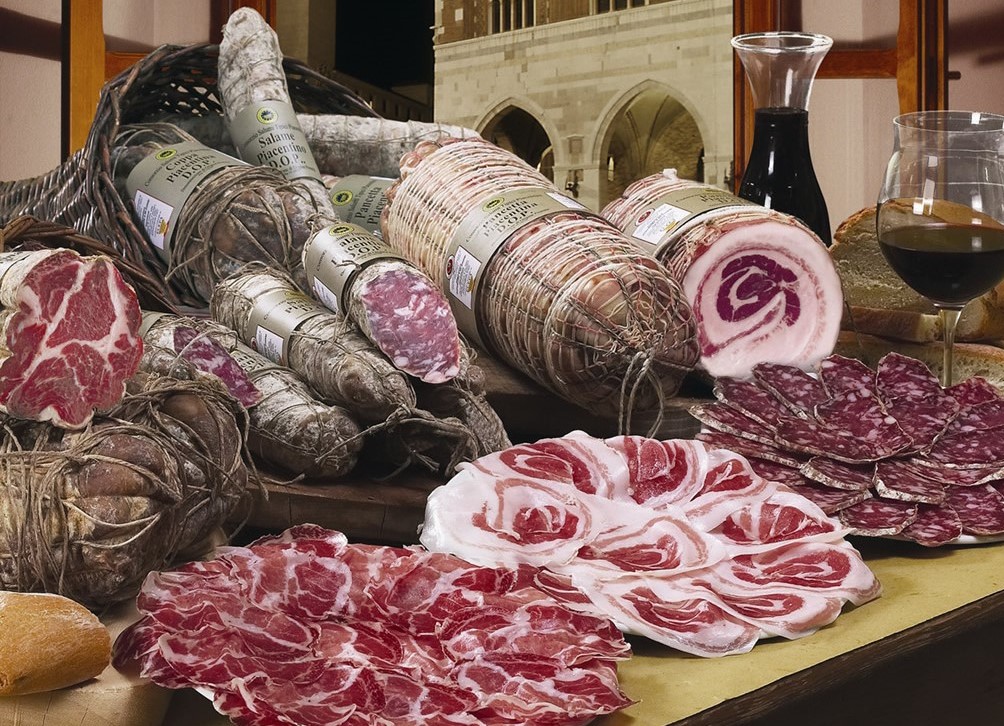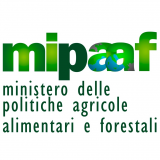
In Europe, the tradition of eating pork meat stretches far back into antiquity, as pigs were an animal that was easy to rear in a domestic environment, they were rich in fat and delicious meats and reproduced quickly. In the second half of the nineteenth century, some pig bones excavated from archaeological sites in the Po Valley corroborated the hypothesis that the inhabitants of this region must have been familiar with swine as early as the Bronze Age, around one millennium prior to the Christian era.
One of the first means used to preserve the meat was heat, which was used for drying or smoking. Preservation in salt only replaced these methods later. In the Middle Ages, techniques for preparing smoked meats developed considerably in Europe, while in France and Italy the manipulation of pork meat preserved with salt grew widespread.
For centuries, even in Emilia, the production of preserved pork meat remained a domestic practice used to meet needs of the family. Around Piacenza, in the early Middle Ages, pigs could only be slaughtered in the presence of a notary, who would certify that the weight of the animal was not less than 250 Kg.
The Medieval era has left us considerable evidence of the prevalence of pork processing practices in the Piacenza region, such as two themed mosaics dating back to the twelfth century, which can be found on the floors of the church of San Savino in Piacenza and the church of San Colombano in Bobbio.
These mosaics depict practices relating to the slaughtering of pigs in December. We have to wait until the fourteenth century to find evidence of the trading of preserved meats in the province of Piacenza, which comes in the form of historical city statutes. These documents show that the sale of preserved meat was solely reserved for members of the guild of cheese makers. The increase in the consumption of processed pork meat subsequently lead to the formation of a specific category of sellers: the “lardaroli”.
They soon joined the guild of cheese makers, creating the “Paratico dei formaggiai e lardaroli” (Association of cheese makers and lardaroli), later shortened to that of the “Shopkeepers”. At the end of the eighteenth century, one hundred and eighty six people were enrolled.
The pork meats processed in this province were highly regarded by shopkeepers in Milan and Lombardy, who used to differentiate them by calling them “roba de Piasenza” (things from Piacenza).
Skill in slaughtering and processing meat gradually became a respected trade in Piacenza, carried out by expert butchers, known as “massalein” in the local dialect.
In the winter months, these men would come down from the mountain areas and go to the homes of their clients to slaughter the pigs and process the meat. It was in the early decades of the eighteenth century that the reputation of their cold meats reached the courts of France and Spain, thanks to a talented diplomat from Piacenza, Cardinal Giulio Alberoni, who used cured meats and cheese produced in Piacenza to win the favour of influential people, and succeeded in earning himself the post of prime minister to the Spanish Court.
In the letters exchanged between Alberoni and the new sovereign of Spain, Elisabeth Farnese, the queen was in the habit of asking him for supplies of Piacenza cold meats, a particular favourite of hers. Finally, in the early twentieth century, the local processing of salted meats and sausages began to grow and take on semi-industrial connotations, which continued to increase over the years until finally becoming the industry it is today, represented by numerous companies located throughout the region.
The products
The area that produces Coppa Piacentina, Salame Piacentino and Pancetta Piacentina encompasses the whole territory of the province of Piacenza. To make Coppa Piacentina, a fresh piece of meat weighing at least 2.5 Kg is taken from the neck muscles of the pig once it has been completely drained of blood.
After the muscle mass has been transported to the processing plant, the coppa is trimmed and the blood vessels squeezed out, then it is refrigerated before being processed.
The processing begins with dry salting, which consists of putting the meat into contact with a blend of salt, spices and preservatives. The salting is followed by massaging the meat by hand or in a churner, and it is then cooled in the refrigerator for at least 7 days.
The subsequent stages consist of covering the coppa with the parietal peritoneum membrane from a pig, tying it and piercing it before hanging it up to drain.
Drying takes place in special dryers, in which the temperature oscillates between 15° C and 25° C, with humidity between 40% and 90%, and with adequate ventilation. This stage lasts at least 7 days.
Once the drying has finished, the curing period begins, which takes place in environments with temperatures between 10° C and 20° C, and relative humidity between 70% and 90%. Curing is drawn out for a minimum period of six months from the salting date, and also includes certain periods in underground rooms. The final product must weigh at least 1.5 Kg.
Salame Piacentino DOP is derived from raw ingredients taken from pigs that meet the characteristics indicated in the product specifications. The percentage of fat that can be used ranges from 10 to 30% depending on the lean part used.
For the lean part, the cuts of meat from the heat are removed, while lard, neck and the parts of pancetta (belly meat) without soft fat may be used for the fatty part. The lean pork and the fatty parts are chopped into small pieces and then passed through a mincer with a press with large holes, with a diameter greater than 10mm.
This is followed by salting with a mixture of salt, spices and preservatives.
The salted meat is then mixed and stuffed into pig gut casing, then the product is tied and pierced along the casing. The subsequent drying stage takes place in environments with a temperature between 15° and 25° C, and relative humidity between 40% and 90%.The curing period must last at least 45 days and it takes place in environments with temperatures between 12° and 19° C, and relative humidity of 70 - 90%. The final weight is between 400 g and 1 Kg.
Pancetta Piacentina DOP uses the central part of the fat covering half of the pig carcass, which spans from the retrosternal to the inguinal region, only including the side of the udder. Pancetta is a the fatty cut of pork, obtained by selecting and isolating the so-called “pancettone” (belly), used to make authentic pancetta. Once cut, the piece is grouped and trimmed.
The processing begins with dry seasoning, which consists of putting the meat into contact with a mixture of salt, spices and preservatives. The salted pancetta is then placed in refrigerated rooms with a temperature of 3° - 5° C, and relative humidity of 70 - 90%, where they rest for around 10 days.
Once the period of resting in the cold is over, the meat is scraped in order to remove any residue left over from the processing and any excess salt and spices.
Next the pancetta is rolled and lean meat may be added, then it sewn up the side. Strips of pig bladder, parietal peritoneum membrane or any other type of natural casing taken from a pig may be applied to the ends if they are not covered by the rind. A parietal peritoneum membrane, a natural pig gut casing or vegetable paper may be applied to the side stitching to provide natural protection during the curing.
After having been tied and pierced, the pancetta rests in rooms kept at temperatures from 0° to 5° C for several hours. Next is the drying stage, which takes place for a period of around 7 days, at a temperature between 15° and 25° C. During this stage, the characteristic intense colouration of the rind becomes apparent, which serves as an indicator during the curing process.
The curing stage must last for a period of at least three months from salting and take place in environments with controlled temperatures ranging from 10° to 14°C and relative humidity of 70 - 90%. The final weight of Pancetta Piacentina DOP must be between 4 and 8 Kg.
The local area
The swine used to produce Coppa Piacentina, Salame Piacentino and Pancetta Piacentina DOP must be bred in the Regions of Lombardy Emilia Romagna.The pigs born, raised and slaughtered in these regions meet the requirements established nationally for the raw ingredients of prosciutto from Parma and San Daniele with protected designation of origin. In fact, the livestock must comply with the above requirement regarding breed, feed and farming method.
The pigs must weigh at least 160 kg and be at least nine months old.The butcher is responsible for ensuring the quality and origin of cuts comply with the standards. The producer must retain the slaughterhouse document that accompanies each batch of raw material and certifies its origin and type. The production area for Coppa Piacentina, Salame Piacentino and Pancetta Piacentina DOP includes the whole of the province of Piacenza, though it is limited to areas with altitudes of less than 900 metres because of their particular climatic conditions.
By Consorzio Salumi Tipici Piacentini with MIPAAF



